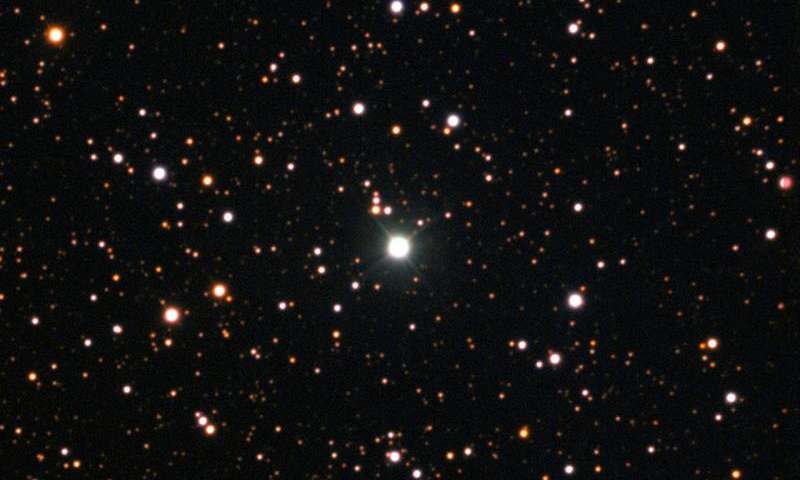A team of Argentinian astronomers, peering up in the night’s sky from the Astronomical Observatory of Córdoba has found a new, young lithium-rich giant star that they designated KIC 9821622. Drawing on data obtained from the GRACES high-resolution spectograph, they were able to determine the star’s mass, radius, age, as well as determine the chemical abundances of 23 elements of the celestial body, which they will be publishing in the December issue of the Astronomy & Astrophysics journal.

Image via phys
The analysis of this star was performed during an on-sky test of the GRACES system (Gemini Remote Access to CFHT ESPaDOnS Spectrograph) conducted in July of this year. The team’s report shows that KIC is an intermediate-mass giant star weighing in at about 1.64 times our Sun’s mass, located some 5,300 light years from Earth, in the Kepler Field. But what’s really caught scientist’s interest is the chemical composition of KIC 9821622; it’s very rich in lithium, and high concentration of this element is very rarely seen in stars — it’s estimated that only 1-2 percent of all known stars boast comparable levels of this element.
Under normal conditions, lithium stands out as being the lightest metal and the least dense solid element in the periodic table. With an atomic number of just 3 protons, you’d expect this element to be very prolific in stars, as a logical progression from hydrogen (Z=1) and helium (Z=2) fusion, but it’s actually very rarely seen in stars large and hot enough to sustain fusion — lithium is actually consumed inside these stars. At the immense temperatures required for hydrogen fusion, lithium atoms collide with protons to form helium in a process known as lithium burning, and isn’t re-created afterwards. In fact, high concentrations of this element are usually a good indicator that a celestial body is substellar, such as brown dwarfs, through the Rafael Rebolo or Lithium test..
This is why scientists are quite puzzled by the find. One theory the authors propose is that the high concentration of lithium can be attributed to a fresh batch of the element that is synthesized near the luminosity bump. Another possibility they’re looking into is that KIC gained its lithium by accretion of planets or brown dwarfs, and it didn’t have time to “digest” the element yet.
However, neither theory is anything more than speculation on their part right now. While the second theory is a bit shaky — up to now, we’ve found no trace of any orbiting planet or binary star system near KIC, let alone one that could have provided the required amount of lithium — the team feels that this is where we should focus our efforts.
“Lithium enhancement in giant stars can be the result of the engulfment of a brown dwarf or planet,” the paper reads.
It’s very important that we understand how or where KIC got its lithium, the authors say — they underline the need for further research of the star, as understanding lithium abundance in stellar photospheres is an important tool in our understanding stellar evolution as a whole.
“To advance in our understanding of these rare objects, it is essential not only to continue the search of lithium rich giants, but also to derive their chemical abundances and to unambiguously establish their evolutionary status,” they write in the paper.
The authors recommend that the star be observed at longer wavelengths than those employed by the GRACE system, such as mid-infrared or submillimeter, as they believe that accretion of a planet would lead to the formation of an ejected-material shell that they could detect as infrared excess.
Aside from being lithium-rich, the scientists found that KIC 9821622 shows also a high abundance of carbon, nitrogen and oxygen. They also managed to derive the star’s precise spectroscopic fundamental parameters, including the effective temperature, surface gravity, metallicity and microturbulent velocity.
“KIC 9821622 is certainly a unique and interesting object that deserves further scrutiny to reveal the real mechanism behind the observed anomalous abundances. In this sense, high-resolution chemical analysis of more of these young giants might help to understand their origin,” the paper concludes.






